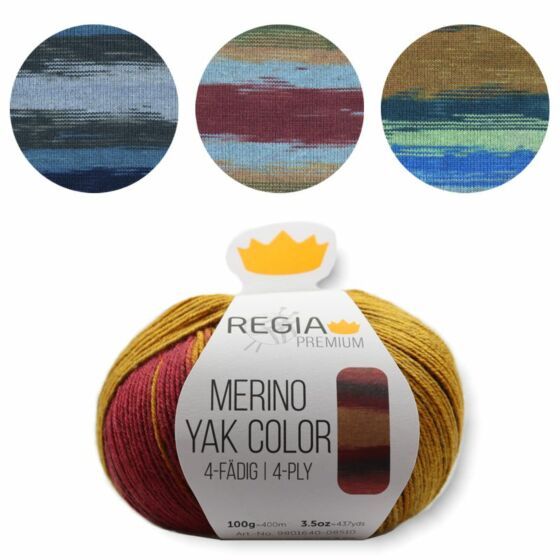Wool made from sheep could vary in strength and softness. Merino sheep wool is frequently believed to be the most soft. This is because of the size of the individual fibers that measure 18-24 mm in diameter. (Cashmere fibers range from 11-12 mm in diameter, and wool made from Romney sheep can range between 29 to 36 millimeters in diameter. Merino wool is very comfortable for knitting projects. Merino wool also offers good warmth, strength, elasticity, modest shine and easy feelability. Here is a list of all the fibers that are used to make knitting yarns.
Characteristics of Fibers
Softness: This is a valuable feature when it comes down to cold-weather clothing.
Strength: This is the term used to describe resistance to Tensile (pulling) force.
Luster Does your hair shine? Usually the lustrous fibers (silk, adult mohair) dye vibrantly.
Elasticity: Does the knitted fabric spring back to its original shape once it has been stretched out? It is contingent on how hard it is pulled. How far does it stretch?
Drape: How is the drape hung? Does it flow
Halo Certain yarns emit a glowing glow that is due to fibers that are not in the center yarn.
Feltability: As agitation increases and changes in water temperature knitted fabrics may become stiff , and in some cases the stitches can become hidden. Different fibers vary in the extent to which they shrink when felted.

The Thermal Properties Of Yak And Merino Wool
Yak and merino wool base layer fabrics are the pinnacle of base layers. Combining merino and yak wool Our base layers provide incredible breathability, warmth as well as comfort and warmth. To offer outdoor enthusiasts the highest levels of comfort, we developed the first yak wool technical fabrics. These fabrics give you superior warmth when you need it, temperature regulation that prevents overheating, natural humidity management and heat regulation. High altitude environments are the key to the woolly warmth of yaks. These tough animals have developed super-wool to withstand the cold winter months and the cold at altitudes of 4,000 to 6,000 meters.
The warmest base layers that we provide The warmest base layers we offer: 60% premium Yak wool 40% supersoft and luxurious Merino. These are a great thermals for men blend.
Other Fibers To Consider
Highland wool is typically produced from Corriedale sheep. It is not quite as soft as merino, but it's stronger than merino, it's warm, and it has excellent elastic properties.
Dual-coated animals sport delicate undercoats that are made of baby camel and Yak Down as well as cashmere. They are extremely soft and warm, and they have a slight elasticity. They're more soft than merino wool. They can give yarns and knitted fabric a subtle look with a halo. They are available in natural hues of gray and brown (as well as white), so they may mute the colors of dyed yarn.
The silk of Mulberry is known as bombyx silk or tussah. These fibers are made from the cocoons produced by moths that produce silk. Mulberry (or bombyx) silk is extremely white and tussah is extremely light golden brown. Both silks are exceptionally strong silks that are soft and luxurious. Silk is cool in warm temperatures and warm in cool temperatures as per my experience. Silks that drape so well that they don't feel elastic.
Mohair, which is a fiber that originates from Angora Angora Goats, is called the fiber. Mohair characteristics depend on the age of the animal. The most soft mohair is kid mohair (first and third clips) with a respectable shine and drapes nicely. However, yearling mohair (third to fourth clips) is quite similar to baby mohair, however it is much stronger and is more glossy. Adult mohair (from goats that are more than 2 years old) can be extremely durable and shiny. It's not elastic and is resistant to being felted. Regardless of age mohair is an extremely warm fiber.
Nylon is a synthetic polymer commonly added to wool yarns to enhance the strength -- and, in turn the endurance of the yarn as well as the knitted object. It has some elasticity , and some luster, however it's not very warm, nor does it take up moisture as well as wool does.
Superwash Merino. To ensure that wool fibers are bonded to each other, they are coated with scales. This feature allows wool yarns to be spun with relatively low twist, and it's in turn responsible for a portion of the springiness and feltability of wool yarns. Superwash wools either have removed or covered the scales of the wool fibers. Superwash wools can possess a little more twist and as a result, knitted materials might not have as much flexibility. Superwash wools will not feel and are machine washable. In most cases, superwash merino is combined with nylon for easy cleaning and long-lasting.
Alpaca (huacaya or suri) gives warmth to knitted fabric and also softens it. It is as soft as merino, if any is as good as similar to merino.
Angora (from Angora bunnies) is incredibly soft. It is extremely comfortable to feel and has a distinct halo.
It is extremely flexible and cool. Merino-cotton blended sweaters are my absolute favorites. These yarns are equally great to make spring and fall garments.

How To Pick The Right Thermal Clothes
Whether you're looking for the best ski base layer or Any other outdoor activities at elevation, we found the yak/merino blend thermal blend to be the most adaptable and comfortable. Here are some suggestions to pick the appropriate type and style of thermals..
1. You Must Ensure That They Do Not Restrict Your Movement
Although thermals are recommended to be worn with skin-fitting against the body, they should also not restrict movement. Thermals can help you improve your performance as it keeps your body warm and shielding it from cold.
2. Check For Smoothness
You won't regret buying thermals regardless of whether you're buying thermals for males or for ladies. Itching and abrasions can be caused by rougher fabrics, bulky seams, as well as zip edges. The smallest irritation could cause a lot of discomfort.
3. Pick The Right Fabric
You can learn the differences between artificial and natural fibres. Find out how heat transfer happens through different materials. We always suggest wool garments for excellent natural moisture wicking, and the capacity to maintain your dry when layering fabrics. Being dry will help you maintain your body temperature for longer. It is more beneficial to be dry, rather than wet. Wool has amazing natural, no-stink attributes that will permit you to wear your gear for longer time periods without needing to wash it. This is especially important if you are on the mountain for long days.
